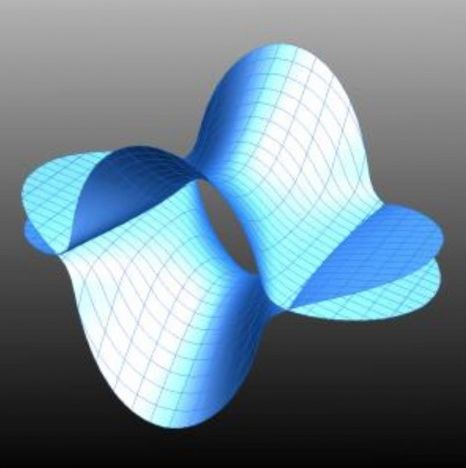Page 11174
May 17, 2016
U.S. startup pursues self-driving semis but big-rig bots still down the road
Posted by Karen Hurst in categories: robotics/AI, transportation
I do see delays of self-driving 18 wheelers across the US. Too many laws & regulations would need to change, consumer safety & protection advocacy groups, etc. will delay this in the US.
SAN FRANCISCO – Picture an 18-wheel truck barreling down the highway with 80,000 pounds of cargo and no one but a robot at the wheel.
To many, that might seem a frightening idea, even at a time when a few dozen of Google’s driverless cars are cruising city streets in California, Texas, Washington and Arizona.
Continue reading “U.S. startup pursues self-driving semis but big-rig bots still down the road” »
May 17, 2016
Mason researchers keep networks moving to stay safe from hacker attacks
Posted by Karen Hurst in categories: cybercrime/malcode, information science, internet, quantum physics
Given the fact that Los Alamos Labs have been and continue to advance cyber security work on the Quantum Internet as well as work in partnerships with other labs and universities; so, why isn’t Mason not collaborating with Los Alamos on developing an improved hacker proof net? Doesn’t look like the most effective and cost efficient approach.
Imagine burglars have targeted your home, but before they break in, you’ve already moved and are safe from harm.
Now apply that premise to protecting a computer network from attack. Hackers try to bring down a network, but critical tasks are a step ahead of them, thanks to complex algorithms. The dreaded “network down” or denial of service message never flashes on your screen.
Continue reading “Mason researchers keep networks moving to stay safe from hacker attacks” »
May 17, 2016
High-efficiency power amplifier could bring 5G cell phones
Posted by Karen Hurst in categories: computing, internet, mobile phones, space, transportation
WEST LAFAYETTE, Ind. – A new highly efficient power amplifier for electronics could help make possible next-generation cell phones, low-cost collision-avoidance radar for cars and lightweight microsatellites for communications.
Fifth-generation, or 5G, mobile devices expected around 2019 will require improved power amplifiers operating at very high frequencies. The new phones will be designed to download and transmit data and videos faster than today’s phones, provide better coverage, consume less power and meet the needs of an emerging “Internet of things” in which everyday objects have network connectivity, allowing them to send and receive data.
Power amplifiers are needed to transmit signals. Because today’s cell phone amplifiers are made of gallium arsenide, they cannot be integrated into the phone’s silicon-based technology, called complementary metal-oxide-semiconductor (CMOS). The new amplifier design is CMOS-based, meaning it could allow researchers to integrate the power amplifier with the phone’s electronic chip, reducing manufacturing costs and power consumption while boosting performance.
Continue reading “High-efficiency power amplifier could bring 5G cell phones” »
May 17, 2016
Invention promises rapid detection of E. coli in water
Posted by Karen Hurst in categories: innovation, materials
“We have developed a hydrogel based rapid E. coli detection system that will turn red when E. coli is present,” says Professor Sushanta Mitra, Lassonde School of Engineering. “It will detect the bacteria right at the water source before people start drinking contaminated water.”
The new technology has cut down the time taken to detect E. coli from a few days to just a couple of hours. It is also an inexpensive way to test drinking water (C$3 per test estimated), which is a boon for many developing countries, as much as it is for remote areas of Canada’s North.
“This is a significant improvement over the earlier version of the device, the Mobile Water Kit, that required more steps, handling of liquid chemicals and so on,” says Mitra, Associate Vice-President of Research at York U. “The entire system is developed using a readily available plunger-tube assembly. It’s so user-friendly that even an untrained person can do the test using this kit.”
May 17, 2016
How nanotechnology could detect and treat cancer
Posted by Karen Hurst in categories: biotech/medical, nanotechnology, neuroscience
The crew of the Proteus has one desperate chance to save a mans life. Shrunk to the size of a large bacterium, the submarine contains a team of scientists and physicians racing to destroy a blood clot in the brain of a Soviet defector. The group journeys through the body, evading giant white blood cells and tiny antibodies while traveling through the heart, the inner ear and the brain to reach and destroy the blockage.
Although events in the film Fantastic Voyage were far-fetched when it was released in 1966, theyre now being realized every day in labs around the world, particularly in cancer treatment. A growing field called nanotechnology is allowing researchers to manipulate molecules and structures much smaller than a single cell to enhance our ability to see, monitor and destroy cancer cells in the body.
Tens of thousands of patients have already received chemotherapy drugs delivered by nanoparticles called liposomes, and dozens of other approaches are currently in clinical trials. Within the next five to 10 years, our bodies biggest defenders may be tinier than we could have ever imagined.
Continue reading “How nanotechnology could detect and treat cancer” »
May 17, 2016
Seeding space with nanosatellites for affordable Internet
Posted by Karen Hurst in categories: internet, satellites

https://youtube.com/watch?v=W0YgV1TgnF8
Luv this as long as it doesn’t pollute space.
Space seeds could bring high-bandwidth Internet connectivity to the globe at less expense than the cost of putting one satellite into space.
Continue reading “Seeding space with nanosatellites for affordable Internet” »
May 17, 2016
Magnetic Hyperbolic Optical Metamaterial Could Advance Thermophotovoltaics
Posted by Karen Hurst in categories: energy, nanotechnology, physics
Improving energy efficiencies — nice.
The remarkable properties researchers at the Australian National University (ARC Centre of Excellence CUDOS) and the University of California Berkeley have discovered in a new nano-metamaterial could lead to highly efficient thermophotovoltaic cells. The new artificial material glows in an unusual way when headed.
As shown in the image, the metamaterial comprises 20 stacked alternating layers of 30-nm-thick gold and 45-nm-thick magnesium fluoride dielectric, perforated with 260 × 530 nm holes that are arranged into a 750 × 750 nm square lattice.
Continue reading “Magnetic Hyperbolic Optical Metamaterial Could Advance Thermophotovoltaics” »
May 17, 2016
The bionic skin that can feel a tumor
Posted by Karen Hurst in categories: biotech/medical, cyborgs, neuroscience, transhumanism
Nice!
Our skin is our largest organ. A gateway between our brain and the rest of the world.
Imagine then a scene where skin could communicate what’s going on inside a human body. It could inform surgeons, provide alerts when our body is about to fall ill, or even diagnose diseases inside another human being, simply through the sense of touch.
May 17, 2016
A Barefoot Run Might Be a Brain Booster
Posted by Karen Hurst in categories: health, neuroscience
The next time that you decide to run barefoot in the rain, etc. there is a health benefit that you’re receiving in the form of enhancing your brain.
FRIDAY, May 13, 2016 (HealthDay News) — Runners who want to boost their brain function should consider taking their running shoes off, new research suggests.
The study found that after running barefoot, participants saw improvements in working memory, or the ability to recall or process information. Running in shoes, however, didn’t result in the same advantage, researchers said.
Continue reading “A Barefoot Run Might Be a Brain Booster” »
















